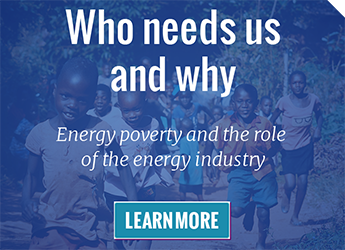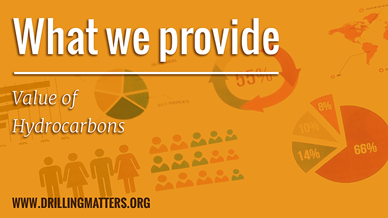
Oil and Gas: Make the Smart Energy Choice
“Energy density” is a useful tool to judge what energy forms make the most economic sense. Energy density can be measured in a couple of ways – by energy content per unit volume, and by energy content per unit of land mass required to generate it. In terms of energy content by volume, the energy density of oil is 30 quadrillion times higher than for solar power. That’s the number “30” followed by 15 zeros. It is the same as 30,000 billion – a very large number.
Although solar and wind power are usually painted as environmentally friendly, they require vast tracks of surface area to generate usable large-scale quantities of power. Oil and natural gas are far superior to most other energy when the surface-area question is considered. Further, wind and solar are not as green as the public infers. Solar farms sacrifice arable land, and wind turbines require rare-earth elements, which are mined open pit and create huge quantities of radioactive and other waste. Further, China controls 85%-95% of the earth’s rare-earth deposits.
In developed countries, we take for granted all the ways these fossil fuels improve and enhance our lives.
Narration Transcript
How does the value of hydrocarbons stack up against other forms of energy, such as renewables? Let’s go to the sources themselves, starting with the sun. Our solar system is diverse, with planets of varied description, dwarf planets, asteroids, passing comets and, of course, Sol, our closest star – the sun.
The planets differ significantly from one another. Only one planet, Earth, is habitable for life as we know it without special protective apparel and precautions.
Similarly, the spectrum of possible energy sources can be differentiated by certain key criteria.
One way to assess the value and usefulness of an energy source is its energy density. Energy density tells us what forms of energy make the most economic sense. Put another way, it indicates which energy types deliver the most bang for your buck. Energy density is measured by the amount of energy per unit volume. In other words, how much energy is contained within a given quantity of material? This is shown on the energy density graph, a logarithmic graph where each number on the vertical axis equals 10 times the number beneath it, rather than 10 plus the lower number, as most graphs work.
As can be seen, solar energy is quite diffuse and produces only 0.0000015 joules per cubic meter, where “joules” are a measure of energy. Geothermal, wind and tidal water score significantly higher, but their contributions are dwarfed by oil, gasoline and natural gas. Oil, the highest-ranking, has an energy density of 45 BILLION – with a BEE-- joules per cubic meter.
The energy density of oil is 30 quadrillion times higher than for solar power. Thirty quadrillion is the number 30 followed by 15 zeros. Thirty quadrillion is the same as thirty thousand billion! It’s a very large number.
Another way to look at energy density is how much land area it actually takes to produce a given quantity of energy.
This information is provided in watts per square meter. A watt is a widely used unit of power.
At the high end of this scale, a nuclear plant produces 56 watts per square meter.
However, cost and fears about nuclear disasters, like the Chernobyl, Ukraine, nuclear accident in 1986 that left cities and towns uninhabitable, present significant barriers.
Ethanol, which in the US is usually created from corn, is at the low end of the scale, at only 0.05 watts per square meter. With that low return on energy investment, we’re probably better off simply eating the corn, rather than filling our gas tanks with it.
Wind delivers only slightly more return on energy investment, producing about 1.2 watts per square meter. Wind farms obviously require a significant amount of land. California’s Tehachapi Wind Farm’s four thousand thirty-one wind turbines sprawl across a whopping 2,400 acres.
Unfortunately, modern wind turbines depend on rare-earth metals, which are not common in minable concentrations. Depending on the source one consults, China controls from eighty-five percent to ninety-five percent of global rare-earth production.
Even so, production and exports are now declining, and concerns of depletion are mounting. Rare-earth elements are important components of cellular telephones and other electronic devices, so tightened supply means higher costs for high tech, as well as wind turbines.
While wind power is considered environmentally friendly, the mining of rare earth elements certainly is not. This video shows sludge contaminated from rare-earth and coal mining being pumped into a ten-kilometer toxic Chinese lake.
Further, Chinese rare earth mines have polluted water and farmlands, to the extent that a study found that nineteen of eighty-five Chinese tea products were contaminated by rare-earth metals.
Due to their low concentrations in the earth, rare earth elements must be mined with open pits, which is obviously very destructive to the environment. In addition, as this image shows, huge pits must be dug for “tailings”, the radioactive slurry almost always produced in rare-earth mining.
The rare-earth industry produces five times more waste gas than all the miners and oil refiners in the U.S. and produces thirteen billion meters of gas and twenty-five million tons of wastewater laden with carcinogenic metals.
Nor are wind turbines bird friendly, killing more than six hundred thousand birds per year. Worse, raptors such as bald eagles and golden eagles are extremely vulnerable to wind turbines. More than two thousand golden eagles have been documented as killed at the Altamont Wind Energy Project in California.
Wind turbines are even a greater threat to bats. Spinning turbines create low-pressure zones near the tips of the blades. When a bat flies into these areas, its lungs are higher pressure than the surrounding air. It expands and can rupture tiny vessels around the lungs, effectively causing the bats lungs to explode. More than six hundred thousand bats were reported killed from wine turbines during 2012. Some sources, however, place the death count as high as nine hundred thousand.
Further, use of wind power is limited geographically, as this map of the US shows. The areas in green are, in general, poor locations for wind farms, and that accounts for a huge swathe of the USA.
Solar voltaic systems also require significant space because these systems can only produce 6.7 watts per square meter. To put this in perspective, the typical 60-watt light bulb uses nearly 10 times the capacity of one square meter of a solar photovoltaic array.
Often portrayed as the poster boy for green, renewable energy, solar also poses significant, little-publicized environmental risks. Depending on location, large-scale solar facilities can cause land degradation and habitat loss. Because solar panels blanket the land, there is little opportunity for solar farms to share land with agriculture.
This NASA photo shows the California’s massive, five hundred and fifty-megawatt Topaz Solar Farm. At nine point five acres, the farm is one-third the size of Manhattan and the same size as 4,598 football fields.
The unreliability and intermittency of solar and wind can be seen by looking at Germany, which reported that 74% of the country’s power needs in 2013 were generated by renewable energy.) Yet, in reality, much of Germany’s actual electricity was provided by solar and wind backed up by fossil fuels.
What about the future of renewable energy? Susan Farrell, vice president of IHS, a global provider of market, industry and technical data and expertise, indicates solid growth for this sector, but does not foresee renewables displacing oil or natural gas.
“It’s mainly power generation, it is power generation,” Ms Farrell said, “and the push behind it is policy.
“It’s to reduce greenhouse gases, to improve air quality, it’s to get cleaner power generation,” she added. “There are a lot of regulatory requirements in place. That means that power generators have to have a certain amount of renewables, so it’s certainly an important part of the fuel mix, and we see it as a growth area.
“We see it as a compliment to gas, not a replacement for gas. They’re both growing very strongly.”
Like our solar system, energy sources each offer unique properties, for better or worse. Energy density tells us what forms of energy make the most economic sense. From this perspective, oil and natural gas are clear winners.







